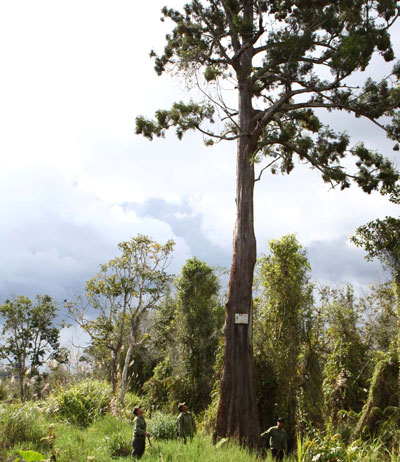Rare yew trees dying slowly in Dak Lak
12/8/2014 8:32:00 AM
More than 100 yews (Glyptostrobus pensilis) in the central province of Dak Lak are dying but scientists say they are still trying to choose the correct way to save them.

One hundred and sixty-two yews in Dak Lak, one of the rarest population of yews left in the world, are in danger of becoming extinct, though they have been put under stringent security precautions.
Yews are considered the living fossils of conifers (Gymnospermae) which appeared on earth 10 million years ago. The plant not only has important scientific significance, but also economic value thanks to its fragrance, colors and patterns, and suitability for making fine arts and handicraft products.
In 1980s, Krong Nang and Ea H’leo districts of Dak Lak province were called the “yew metropolis”. There in the districts, numerous yews grew in the swamps.
There were so many yews that local people did not think much before deciding to clear dozens of hectares of yews to make room for the Ea Ral irrigation dam.
At that time, yews were listed as a kind of low-quality wood. Only in 2008, when rumors were spread that yews could treat cancer did people rush to hunt for yews. They tried to excavate the irrigation dam area to unearth yews which had been cut down many years ago.
Yews turned out to be as expensive as gold since people from all over the country flocked there to buy them. The trees became important objects for illegal loggers.
Tay Nguyen University, which realized that it was urgent to protect the yews, in 2010, conducted a survey of the yew population before discussing measures for conservation.
Researchers counted 256 yews in Dak Lak province, including 219 trees in Ea Ral commune, 31 trees in Trap K’sor of Krong Nang district, five in Cu Ne of Krong Buk district, and one in Buon Don district.
In January 2011, the Dak Lak provincial People’s Committee approved the yew conservation project and the establishment of a yew sanctuary.
However, the move did not help much in protecting the yews. Ninety-four yews were chopped down and only 162 were left.
According to Dr. Tran Vinh, deputy head of the Central Highlands’ Agriculture and Forestry Science & Technology Institute, 39.7 percent of the yews in Ea Ral can be listed as A-class trees (the highest quality), 42.5 percent B-class and 17.8 percent C-class.
The figures are 20 percent, 46.7 percent and 33.3 percent, respectively, in Trap K’sor commune. Meanwhile, the other remaining trees are classified as C-class.
The statistics showed a decline not only in the number of trees left, but also in quality.
Source: VietNamNet Bridge
Lượt xem : 3053